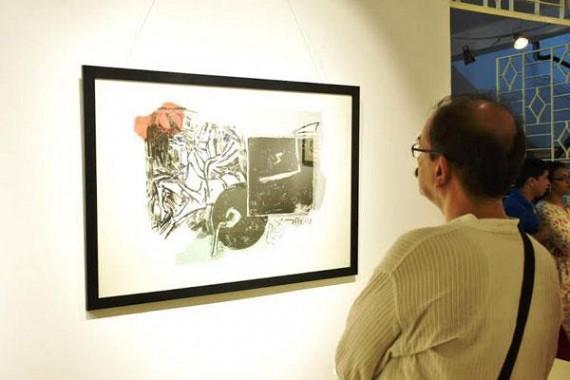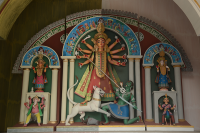 image
image
M F Husain: Economy of lines his forte
M. F. Husains favourite city Kolkata recently paid tribute on his birth centenary year with a multi-layered event Husain 100. Uttara Gangopadhyay reports
Artist Maqbool Fida Husain was abroad while some of his paintings were being denounced and vandalised at home in India. As Husainwas preparing to return home, his friend Arun Relia wanted to know which would be his arrival city. “Husain chose Calcutta,” said Relia. The artist felt Calcutta (as Kolkata was then known ) would be the safest place to wait for the storm to abate, said Relia while speaking at a special five-day event titled ‘Husain 100’ organised in Kolkata recently.
The centenary celebration was organised by Virasat Art, an online contemporary art gallery spearheaded by Ganesh Pratap Singh along with a host of others, including the Government College of Art and Craft, Society of Contemporary Artists, Reflections of Another Day (RAD), Third Eye, Spectrum Artists’ Circle, Young Artists Painter Circle and Calcutta Painters.
The Kolkata celebration also finally put to rest the ghost of a controversy that erupted in the city in 2003. Kolkata-based Galerie 88 had decided to observe Husain’s 88th birthday with an exhibition of 88 of his paintings. But miffed by a comment purportedly made by Husainthat most Bengal painters lack stamina and energy, West Bengal’s artist community boycotted the exhibition. Even the then chief minister of West Bengal, Buddhadev Bhattacharya, known for his cultural inclinations, failed to turn up for the scheduled inauguration of the exhibition..jpg)
The maverick artist, who eschewed footwear, began his career painting billboards for cinemas and rose to become an iconic artist with a formidable portfolio. His 1956 painting Between the Spider and the Lamp was used for a commemorative stamp by Indian Post; he was called the ‘Picasso of India’ by Forbes magazine; he was awarded Padma Bhushan (1973) and Padma Vibhushan (1991) but was often targeted for his paintings of Indian goddesses.
But one particular painting, put up for auction by a Chennai-based non-profit, drew the ire of a section of Indians. Though Husainclarified that he had not named the painting as Bharat Mata, they refused to accept his explanation. Troubled by constant threats and court cases, Husain finally went into a self-imposed exile and died in Qatar in 2011.
Art historian Geeti Sen reiterated that Husain never named the controversial painting as Bharat Mata; he had executed it as a private work for a buyer. But people refused to listen to Husain when he said that it was somebody else and not he who had named the painting. Sen recalled how Husain occasionally loved to indulge in a little drama but he never belittled any one. Once he had painted a picture of Ma Durga as she is worshipped in Bengal and then covered it with white paint to symbolise the immersion of the idol that takes place on the last day of the festival.
‘Husain 100’ was all about refreshing people’s knowledge about the great artist and an acknowledgement of his contribution to modern Indian art was how Partha Pratim Roy of RAD, who mainly scripted the show, introduced the five-day festival, which included, apart from the exhibition of paintings, a display of books by and on Husain, his posters from the film Gajagamini and others, seminars and lectures on his work and life, and film screening (Vision 20th Century – Paintings by M F Husain).
The exhibition, spread across the three galleries of the Academy of Fine Arts, comprised a wide-range of Husain’s paintings, including those inspired by Kolkata’s icon Mother Teresa and of course, his famous horses. “I have heard so much about Husain and now standing in front of his paintings, I am thrilled,” gushed Ahana Mukherjee of Barasat, an aspiring artist. Her friend, Bhaskar Das, was studying the use of colour to convey various moods. “When he makes a woman wear a red sari, it gives her such a subtle look. But when he uses the same red colour as background to the horses, the picture turns grim,” observed Das.
Interpreting Husain is not an easy task, acknowledged renowned scientist P M Bhargava, whose friendship with the artist is well-known. “It’s difficult to talk about Husain. I don’t know where to start,” said Bhargava reminiscing about the artist at the centenary celebration. “Everything about him was unique. He would be involved in a variety of activities but managed to do them differently.”
.jpg) According to Bhargava, Husain was sparing with his words; he was a keen observer of everything around him but not a slave to them. Like many of Husain’s ardent fans, he was pained by the artist’s decision to go on self-imposed exile but the artist had little choice as Hindu fundamentalists hounded him.
According to Bhargava, Husain was sparing with his words; he was a keen observer of everything around him but not a slave to them. Like many of Husain’s ardent fans, he was pained by the artist’s decision to go on self-imposed exile but the artist had little choice as Hindu fundamentalists hounded him.
Husain had vast knowledge about the epics, Ramayana and Mahabharata. “He had more knowledge about the epics than I had,” said Bhargava, adding, “Husain had internalised the content.” Between 1971 and 1990, Husain came out with several series of hisMahabharata paintings. He also painted another series based on the Ramayana.
Many speakers at ‘Husain 100’ described how fast Husain could visualise and paint. Bhargava attributes this to his ‘economy of lines’. “He could express everything in few lines,” he explains.
Once Husain visited the Alimmuddin Street office of the Communist Party of India – Marxist, in Kolkata, recalled art critic, writer and poet Suneet Chopra. He wanted to know what the various newspapers were saying about the Gujarat riots. Then he suddenly got up, pinned a copy of the Ganashakti newspaper, the CPM party’s mouthpiece, on the wall and began to paint. That was his way of relieving himself from the stress, said Chopra.
Probably it was Chopra who, through his poem A Conversation with Husain, best expressed what Husain wanted to say –
“…he tells me when we speak of how a
drawing finished in minutes fetches
such a high price, how “each moment of my
seventy five years of life is in it,
so the price they pay is for that..”
Probably, the best compliment to the ‘Husain 100’ came from the artist’s son Mustafa, who said, “My father would have been very happy if he was present here today. After all Kolkata was his favourite city.”
Top Headlines
-
Art and Culture
Beyond Old and New: Bickram Ghosh and the Art of Fusion at Serendipity
December 25, 2025
-
Art and Culture
Saptak Music School of Pittsburgh hosts spellbinding evening of Indian classical music
September 23, 2025
-
Art and Culture
Zigzag to clarity: Sonal Mansinghs dance of life captivates Delhi
September 08, 2025
-
Art and Culture
USA: Santoor Ashram Kolkata mesmerises Los Angeles with a celebration of Indian classical music
August 27, 2025
-
Art and Culture
'Feels like a tonic in my musical pursuits': Flute virtuoso Pandit Ronu Majumdar receives Padma Shri
June 06, 2025
-
Art and Culture
Of Paris, a chronic pain and a pivotal friendship: Frida Kahlo meets Mary Reynolds at the Art Institute of Chicago
April 16, 2025
-
Art and Culture
Prabha Khaitan Foundation celebrates 'Vasant Utsav' at Indian Museum Kolkata
March 15, 2025
-
Art and Culture
Musical concert 'Ami Bhalobashi Bangla Ke' to be held in Kolkata on April 19
February 20, 2025
-
Art and Culture
A kiss in front of The Kiss? Vienna museum's V-Day offer is ode to Klimt's artistic masterpiece
February 10, 2025
-
Art and Culture
Dalhousie Square: Timekeeping with Kolkata's British gems
January 12, 2025

